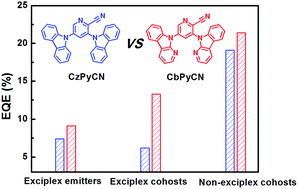当前位置:
X-MOL 学术
›
J. Mater. Chem. C
›
论文详情
Our official English website, www.x-mol.net, welcomes your
feedback! (Note: you will need to create a separate account there.)
Carbazole/α-carboline hybrid bipolar compounds as electron acceptors in exciplex or non-exciplex mixed cohosts and exciplex-TADF emitters for high-efficiency OLEDs†
Journal of Materials Chemistry C ( IF 5.7 ) Pub Date : 2018-07-18 00:00:00 , DOI: 10.1039/c8tc02353k Qingjing Wu 1, 2, 3, 4, 5 , Menghan Wang 1, 2, 3, 4, 5 , Xudong Cao 1, 2, 3, 4, 5 , Di Zhang 1, 2, 3, 4, 5 , Ning Sun 5, 6, 7, 8 , Shigang Wan 1, 2, 3, 4, 5 , Youtian Tao 1, 2, 3, 4, 5
Journal of Materials Chemistry C ( IF 5.7 ) Pub Date : 2018-07-18 00:00:00 , DOI: 10.1039/c8tc02353k Qingjing Wu 1, 2, 3, 4, 5 , Menghan Wang 1, 2, 3, 4, 5 , Xudong Cao 1, 2, 3, 4, 5 , Di Zhang 1, 2, 3, 4, 5 , Ning Sun 5, 6, 7, 8 , Shigang Wan 1, 2, 3, 4, 5 , Youtian Tao 1, 2, 3, 4, 5
Affiliation

|
Two cyanopyridine derivatives CzPyCN and CbPyCN are designed and synthesized through a simple catalyst free aromatic nucleophilic substitution reaction by using 2-cyano-3,5-difluoropyridine as the electrophile and carbazole (Cz) or α-carboline (Cb) as the nucleophile. CbPyCN exhibits blue-shifted emission (λmax at 420 nm), a wider optical band-bap (Eg: 3.22 eV) and a higher triplet energy (ET: 2.79 eV) than CzPyCN (454 nm, 3.02 and 2.69 eV). The HOMO/LUMO energy levels were −5.77/−2.75 and −5.58/−2.38 eV for CzPyCN and CbPyCN, respectively. With enough HOMO/LUMO energy level offsets, CzPyCN and CbPyCN could function as electron acceptors to form an exciplex with a typical electron-donor, di-[4-(N,N-ditolyl-amino)-phenyl]cyclohexane (TAPC), showing broad exciplex emission with peaks at 530 and 520 nm, and long decay lifetimes of 1097 and 1014 ns, respectively. However, when mixed with 1,3-di(9H-carbazol-9-yl)-benzene (mCP), no exciplex but only typical CzPyCN or CbPyCN deep blue emission with a decay lifetime of 14.3 or 12.1 ns is observed. Blue phosphorescent OLEDs by using mCP (TAPC)/CzPyCN as mixed cohosts show a maximum EQE of 19.1 (6.2)%, lower than the 21.4 (13.3)% of mCP (TAPC)/CbPyCN, respectively, which is probably due to the better electron-transport properties and higher triplet energy levels for electron-deficient α-carboline containing CbPyCN. Similarly, exciplex-type green fluorescent OLEDs based on TAPC/CzPyCN show a lower maximum efficiency of 22.0 cd A−1 and 7.4% than 27.5 cd A−1 and 9.1% of TAPC/CbPyCN.
中文翻译:

咔唑/α-咔啉杂化双极化合物在高效复合物的激基复合物或非激基混合混合主体和激基复合物-TADF发射体中作为电子受体†
以2-氰基-3,5-二氟吡啶为亲电子体,以咔唑(Cz)或α-咔啉(Cb)为亲核体,通过简单的无催化剂芳族亲核取代反应,设计合成了两种氰基吡啶衍生物CzPyCN和CbPyCN。CbPyCN表现出蓝移发射(λ最大在420nm处),更宽的光学带BAP(É克:3.22电子伏特)和一个较高的三线态能量(Ë Ť:2.79 eV)的比CzPyCN(454纳米,3.02和2.69 eV)的。CzPyCN和CbPyCN的HOMO / LUMO能级分别为-5.77 / -2.75和-5.58 / -2.38 eV。有了足够的HOMO / LUMO能级偏移,CzPyCN和CbPyCN可以充当电子受体,与典型的电子给体di- [4-(N,Ñ -ditolyl -氨基) -苯基]环己烷(TAPC),显示了分别在530峰和520纳米,以及1097个1014纳秒长衰减寿命,宽激基复合物的排放。但是,当与1,3-二(9 H-咔唑-9-基)-苯(mCP)混合时,没有观察到激基复合物,只有典型的CzPyCN或CbPyCN深蓝色发射,衰减寿命为14.3或12.1 ns。通过使用mCP(TAPC)/ CzPyCN作为混合共基质的蓝色磷光OLED显示的最大EQE为19.1(6.2)%,分别低于mCP(TAPC)/ CbPyCN的21.4(13.3)%。缺电子的含α-咔啉的CbPyCN的电子传输性质和更高的三重态能级。同样,基于TAPC / CzPyCN的激基复合物型绿色荧光OLED显示出的最大效率较低,为22.0 cd A-1和7.4%比27.5 cd A -1和9.1%的TAPC / CbPyCN。
更新日期:2018-07-18
中文翻译:

咔唑/α-咔啉杂化双极化合物在高效复合物的激基复合物或非激基混合混合主体和激基复合物-TADF发射体中作为电子受体†
以2-氰基-3,5-二氟吡啶为亲电子体,以咔唑(Cz)或α-咔啉(Cb)为亲核体,通过简单的无催化剂芳族亲核取代反应,设计合成了两种氰基吡啶衍生物CzPyCN和CbPyCN。CbPyCN表现出蓝移发射(λ最大在420nm处),更宽的光学带BAP(É克:3.22电子伏特)和一个较高的三线态能量(Ë Ť:2.79 eV)的比CzPyCN(454纳米,3.02和2.69 eV)的。CzPyCN和CbPyCN的HOMO / LUMO能级分别为-5.77 / -2.75和-5.58 / -2.38 eV。有了足够的HOMO / LUMO能级偏移,CzPyCN和CbPyCN可以充当电子受体,与典型的电子给体di- [4-(N,Ñ -ditolyl -氨基) -苯基]环己烷(TAPC),显示了分别在530峰和520纳米,以及1097个1014纳秒长衰减寿命,宽激基复合物的排放。但是,当与1,3-二(9 H-咔唑-9-基)-苯(mCP)混合时,没有观察到激基复合物,只有典型的CzPyCN或CbPyCN深蓝色发射,衰减寿命为14.3或12.1 ns。通过使用mCP(TAPC)/ CzPyCN作为混合共基质的蓝色磷光OLED显示的最大EQE为19.1(6.2)%,分别低于mCP(TAPC)/ CbPyCN的21.4(13.3)%。缺电子的含α-咔啉的CbPyCN的电子传输性质和更高的三重态能级。同样,基于TAPC / CzPyCN的激基复合物型绿色荧光OLED显示出的最大效率较低,为22.0 cd A-1和7.4%比27.5 cd A -1和9.1%的TAPC / CbPyCN。











































 京公网安备 11010802027423号
京公网安备 11010802027423号